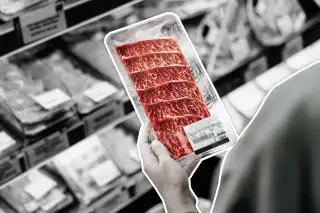Meat Prices Are Seriously out of Hand

Your favorite steak dinner is a lot pricier than it used to be, as is that side of bacon with your pancakes.
Meat prices overall were 14.5% higher in October compared to the same month last year, and bacon and beef are up 20% or more over the past 12 months, according to data from the Bureau of Labor Statistics.
Consumer prices in general rose 6.2% on a yearly basis in October, with food prices up 5.3%. In other words, meat prices are rising much, much faster than most other everyday purchases.
"Meatflation" can vary widely depending on the product at hand. More expensive meats like beef and veal have seen the biggest surges over the past year, while traditionally cheaper options like chicken and lunchmeat have experienced more moderate price hikes. (One silver lining? Hot dogs are actually 3.3% cheaper than they were last year.)
Why are meat prices so high?
In a blog post for Econofact, Purdue University economist Jayson Lusk notes that packing plant closures in the early days of the coronavirus pandemic were initially to blame for rising meat prices. Even though the plants are open again, Lusk writes that producers and distributors are dealing with the extra costs of pandemic-related measures like social distancing and protective equipment. Those added costs are trickling down to grocery shoppers, who are seeing prices spike for their favorite cuts of meat.
The Biden administration has pointed to consolidation in the meat industry – just four firms control the majority of the market for beef, pork and poultry in the United States – as another reason prices are so high, and it is seeking to crack down on anti-competitive practices. An ongoing labor shortage, a supply chain meltdown that’s delaying shipping and transportation, and soaring consumer demand are all exacerbating the issue and causing rising prices well beyond the meat counter.
Meanwhile, some grocery stores are struggling to hire employees and being forced to cut hours. Consumers should prepare for occasional shortages on shelves during the holidays thanks to delays at ports and in warehouses. Add it all together and you have a recipe for a very expensive, frustrating grocery run, since meat producers (and other food companies like Mondelez International, maker of Oreos and Sour Patch Kids) are now hiking prices to protect their bottom lines from all those extra costs.
Unfortunately, shoppers should not expect relief anytime soon. In fact, there are signs that more price increases are likely in the supermarket, and in the meats section in particular.
Tyson Foods said this week that the average price consumers pay for its beef products rose by about 33% last quarter, while pork prices jumped 38% and chicken prices rose 19%. The company is preparing for even more price hikes next year, as are Kraft Heinz and Conagra. CNN reported that consumers can expect price increases on Jimmy Dean frozen breakfast products, Hillshire Farm lunch meat and sausages, Ball Park burgers and hot dogs, and Hebrew National and Oscar Mayer hot dogs.
How high meat prices are rising
Here’s how much prices of popular meat products have risen over the past year, according to the Bureau of Labor Statistics:
- Beef steaks: 24.2%
- Bacon: 20.2%
- Pork chops: 15.9%
- Ground beef: 13.4%
- Chicken: 8.8%
- Ham: 7.1%
- Lunchmeat: 3.1%
More from Money:
From Oreos to Sour Patch Kids, a Bunch of Your Favorite Snacks Are Getting More Expensive
4 Ways the Labor Shortage Could Wreck Your Holiday Plans
Holiday Shortages! Toys, Turkeys, Christmas Trees and (Gulp) Wine Could All Be Hard to Come by